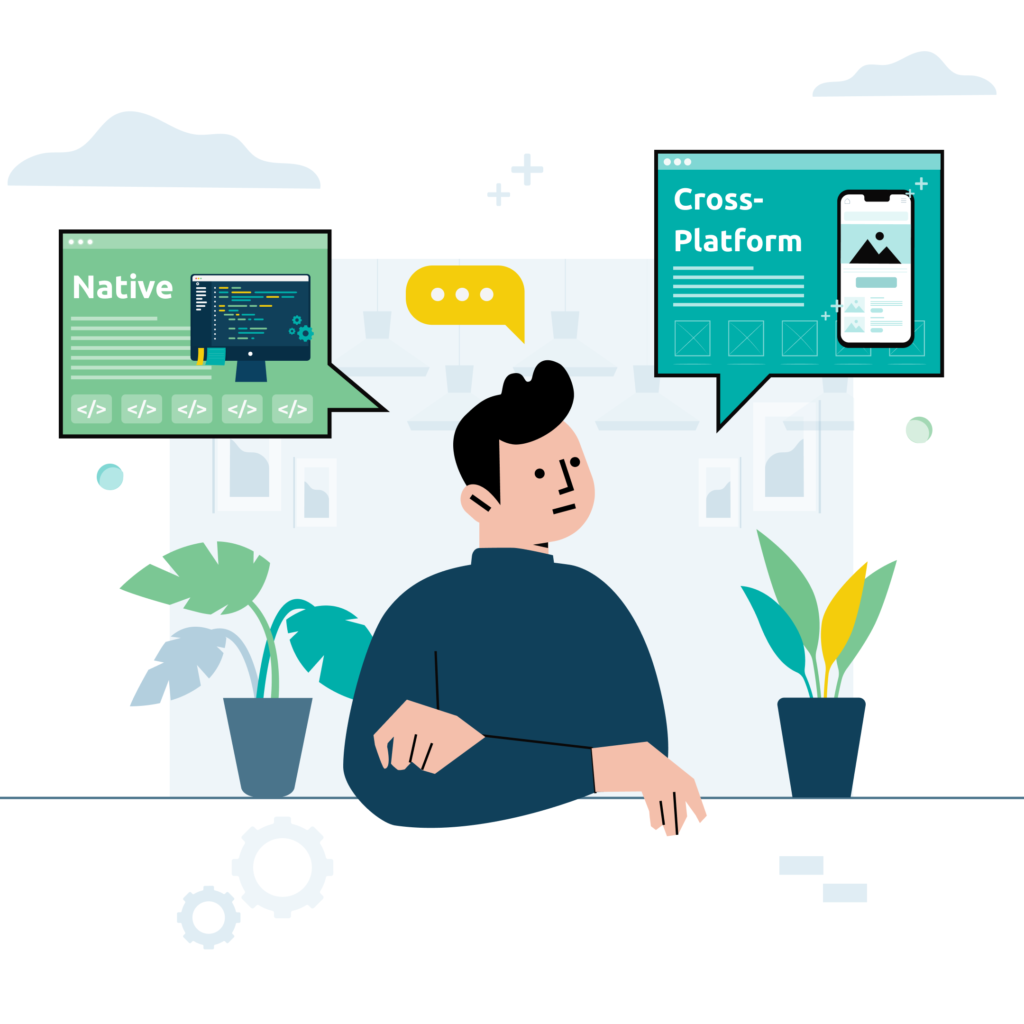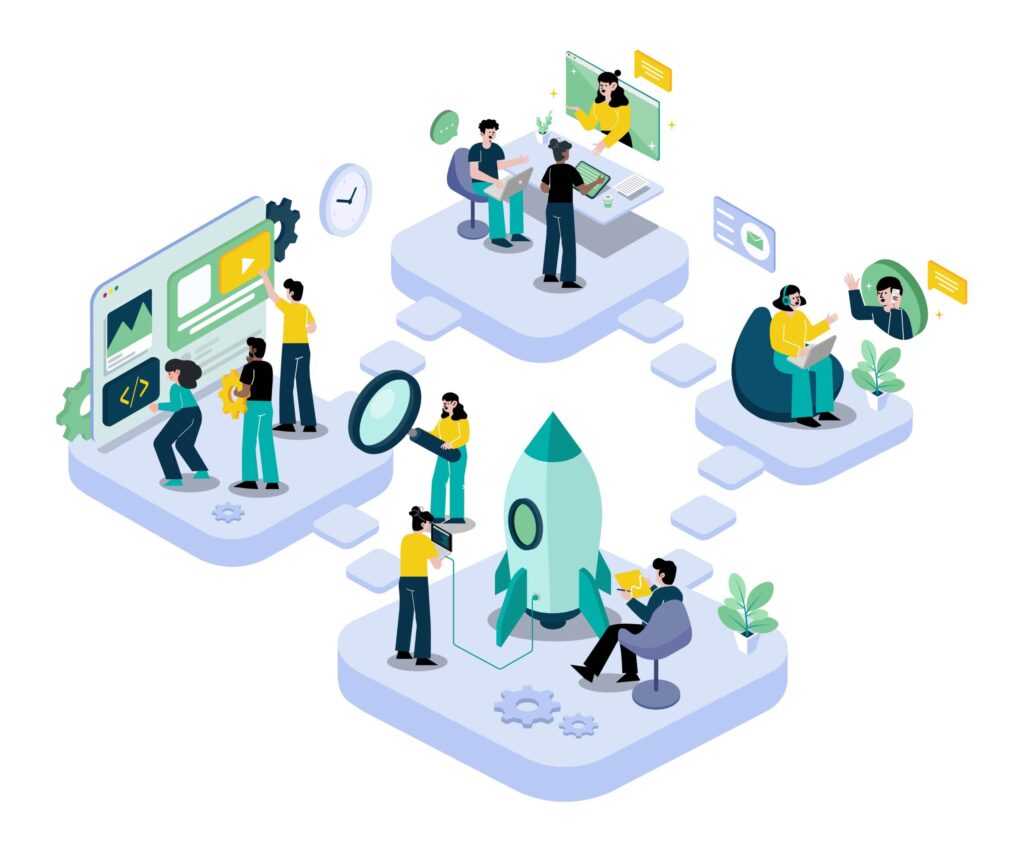The choice between native and cross-platform development sets your app’s trajectory from day one. It determines your development costs, your timeline to market, and the size of your potential user base.
This decision locks in how you’ll maintain and update your app. It affects the speed at which you can roll out new features and respond to user feedback. Most importantly, it defines how much time and money you’ll need to spend keeping your app competitive as mobile platforms evolve.
Your choice here shapes how users experience your app on each platform. If they get frustrated by an interface that doesn’t match their expectations, they’ll delete your app. And if Apple or Google release a new feature your users want, how fast you can deliver it depends on the development path you chose.
This isn’t just about development. It’s about costs. Getting this right means you spend less time fixing problems and more time building features. Get it wrong and you end up paying developers to rewrite chunks of your app when platform updates break things.
You have two ways to build your app. Native development means building a separate app for each platform using their standard languages – Swift or Objective-C for iOS, Kotlin or Java for Android. You end up with two codebases and probably two development teams.
Cross-platform development lets you build one app that works on both platforms. This uses frameworks that act as translators between your code and each platform’s requirements. This cuts development time and costs, but you trade that for limits on performance tuning, access to new platform features, and how closely you can match each platform’s interface guidelines.
This article lays out a process for making the choice between native and cross-platform development. We’ll examine the factors that matter – development costs, technical requirements, and resource constraints. We’ll also look at the trade-offs between speed to market and platform-specific capabilities.
By working through these factors step by step, you’ll be able to determine which approach fits your business needs, your development team, and your budget. No theoretical discussions, just practical guidance based on real-world constraints.
Cost And Timeline Considerations
The cost difference between native and cross-platform development is clear. Cross-platform development reduces costs by using a single codebase for all platforms. Building separate native apps costs about 35% more when you count setup, training and development time.
Maintenance costs follow a different pattern. Native apps need separate teams and codebases for iOS and Android. But those teams can update and optimise their apps without waiting for cross-platform frameworks to catch up with platform changes.
Timelines follow costs. Cross-platform development gets your MVP in front of users in 3-4 months. Native development takes longer to launch but makes it easier to build complex features that match what each platform can do.
Maintaining Mobile Apps At Scale
Your app maintenance is going to be an ongoing cost. Every time Apple or Google update their OS, you’ll need to test and update your app. Every time a user finds a bug, you’ll need to fix it. And every time a competitor adds a feature, you’ll need to match it.
Your development approach determines how much work these updates take. Native development means you can apply platform-specific fixes quickly. Cross-platform means one fix works everywhere, but you’re waiting for the framework to catch up with new OS features. You need to consider how much time your team will spend keeping the app running versus building new features.
Success Stories And Case Studies
Looking at real-world examples shows both native and cross-platform approaches work when matched to business needs. Bank of America serves 31 million users through their native banking app. Spotify delivers music recommendations and playback to 356 million monthly users with native apps.
Cross-platform development has moved beyond being just a way to cut costs. Uber Eats used cross-platform tools to speed its global rollout. Alibaba reduced development costs by 50% while maintaining performance. Bloomberg, Skype, Airbnb and Walmart run cross-platform apps.
Performance And Hardware Considerations
Your app’s performance needs will push you towards native or cross-platform development. Apps that process video in real-time, render complex animations, or handle AR need direct access to device hardware. Native development gives you this access through platform tools like Android’s Native Development Kit and iOS’s Metal API.
Cross-platform frameworks put a layer between your code and the device. This layer limits how much of the hardware you can access. For most business apps this doesn’t matter. But if your app needs to squeeze every bit of performance from a device, that layer becomes a problem.
Hardware access is another factor that pushes you toward native development. Native apps get direct access to device features like cameras, sensors, Bluetooth, and NFC. Cross-platform frameworks provide access to these features through plugins and APIs, but this adds complexity and can limit what you can do with the hardware.
This matters most on Android where device capabilities vary between manufacturers and models. You need to specify which hardware features your app requires in the app manifest. These declarations prevent your app from being installed on devices that can’t support it.
The hardware requirements of your app shape your development choice. If you need precise control over device hardware, native development gives you that control. If basic hardware access is enough, cross-platform development works fine.
Team Skills And Technology Stack
Your development team’s skills are a key factor in choosing between native and cross-platform. A team that knows Swift/Objective-C for iOS and Kotlin/Java for Android can start building native apps now. Teams with JavaScript experience will get results faster with React Native. If your developers work in C#, .NET MAUI makes sense.
Framework dependencies create risks. When Apple or Google release new features, cross-platform tools take weeks or months to support them. This means you can’t roll out platform features until your framework catches up.
You need to balance your team’s current skills against future needs. Moving to a new technology stack means training costs and delayed development while your team learns the tools.
Development Timeline Factors
Development timelines drive many decisions around native versus cross-platform approaches. Cross-platform development gets a basic app to market faster by using a single codebase. But this depends on your app’s requirements and your team’s skills.
Simple apps built with standard UI elements launch faster through cross-platform frameworks. Apps that need platform-specific features or pixel-perfect interfaces take longer to build with cross-platform tools. Native development provides faster iteration once the initial setup is complete. Teams launching MVPs or testing concepts often start with cross-platform frameworks to validate their ideas before committing to a development path.
Budget And Financial Impact
The cost implications of your development choice go beyond the initial build. Native development requires two teams – one for iOS and one for Android. This doubles your development costs through separate codebases and platform-specific developers. Cross-platform frameworks cut these costs by up to 40% by letting one team build for both platforms.
But long-term costs follow a different pattern. Native apps provide clear maintenance paths within each platform’s ecosystem. Cross-platform solutions need extra work to stay compatible as platforms evolve. This matters when new platform features arrive – native development lets you implement things like AI and machine learning APIs faster. If these technologies are core to your app strategy, the higher initial cost of native development could save money later.
User Interface Design Considerations
Platform UI guidelines shape how your app needs to work. Apple’s Human Interface Guidelines and Google’s Material Design define distinct interaction patterns and visual styles. Each platform has specific navigation patterns and UI behaviors.
Cross-platform frameworks provide tools to handle these differences, but matching native behaviors exactly remains challenging. Your app needs to balance your brand’s visual identity against platform-specific UI expectations. This often means implementing custom designs for core brand elements while using platform-standard components for navigation and common interactions.
Native Development Frameworks
Native development means building separate apps for iOS and Android. For iOS apps, developers use Swift or Objective-C in Apple’s Xcode environment. This gives them full access to iOS features and lets them optimise performance for iPhones and iPads.
Android development works the same way. Developers build apps using Kotlin or Java in Android Studio. Like iOS native development, this provides complete access to Android features and performance tuning.
This two-platform approach requires your team to maintain two separate codebases. But it removes any limitations on what your apps can do on each platform.
React Native Development
React Native uses JavaScript and the React framework to build cross-platform apps. The framework’s large developer community provides libraries and solutions that cut development time. Teams build one codebase that works on both iOS and Android, and features like hot reloading let developers test changes without rebuilding the app.
But React Native trades flexibility for speed. Complex interfaces or CPU-heavy tasks require native modules to access platform features. These modules can introduce bugs that only appear on one platform, undermining the single codebase approach.
React Native works best for apps that don’t push hardware limits. Teams with JavaScript experience or those testing new product ideas get results fastest with React Native. Once user demand grows or performance becomes critical, teams can move to native development.
Expo Development Platform
Expo builds on React Native by handling configuration and setup. Teams can start building apps with minimal technical overhead using Expo’s managed workflow, pre-built components, and over-the-air updates.
The trade-off is that Expo’s managed workflow limits access to native platform features. Apps built with Expo end up larger than standard React Native apps, and you depend on Expo’s infrastructure. While you can ‘eject’ from the managed workflow to gain platform access, this adds complexity that defeats the purpose of using Expo.
Expo works best for MVPs, internal tools, and apps that don’t need deep platform integration. If you need to validate an idea quickly or build a straightforward business app, Expo reduces the time between concept and deployment.
Flutter Development Framework
Flutter takes a different path to cross-platform development by using Google’s Dart programming language. The framework gives you direct control over UI elements and animations, making it suitable for apps that need visual polish. Flutter’s hot reload feature lets developers see code changes instantly, speeding up the development cycle.
Flutter extends beyond mobile – the same codebase runs on web browsers and desktop platforms. This makes Flutter attractive if you plan to expand your app’s reach. But there are costs. Your development team needs time to learn Dart, your apps will be larger than native builds, and accessing platform-specific features requires extra work.
The framework fits projects where interface design and performance drive decisions, especially when your product roadmap includes expansion to web and desktop platforms.
Xamarin And MAUI Development
Microsoft’s Xamarin/MAUI offers a path to cross-platform development for organisations using .NET. Built on C# and the .NET framework, MAUI is Microsoft’s evolution of Xamarin. The platform lets you share code between iOS and Android apps while Xamarin.Forms handles the UI layer. MAUI expans these capabilities with better native UI performance.
Developers get access to .NET’s libraries and tools, but MAUI apps come with trade-offs. The apps run larger than native builds and perform slower than pure native code. The developer community is smaller than React Native or Flutter, and teams report more platform-specific issues.
MAUI works best for enterprise applications where teams already know .NET. The decision to use it comes down to your existing technology stack – if you’re running .NET, MAUI makes sense. If not, the overhead of adopting Microsoft’s ecosystem outweighs the benefits.
Resource Management And Team Structure
Native development means building two separate apps – one for iOS in Swift and one for Android in Kotlin. Each app needs its own developers and tools. This separation gives you full access to platform features but requires expertise in multiple programming languages.
Cross-platform development uses a single codebase to target both platforms. This means one team can build for both iOS and Android. But you depend on framework updates to access new platform features, and the compatibility layer between your code and the platform can slow things down.
Testing And Deployment Strategies
Testing and deployment differ between native and cross-platform apps. Native development requires your team to work with separate testing tools for iOS and Android. This means setting up testing environments for both platforms and running tests on actual devices to verify performance. You’ll submit apps through two separate processes – App Store Connect for iOS and Google Play Console for Android.
Cross-platform development reduces initial testing work by letting you verify core functionality once across platforms. But you still need to test on actual devices to catch platform-specific UI and feature issues. When submitting to app stores, cross-platform apps go through the same processes as native apps, with extra verification steps to ensure your framework integrates correctly with each platform.
Maintenance And Updates
Maintenance costs look different between native and cross-platform apps. Native development means maintaining two codebases. Each needs its own updates and bug fixes. When Apple releases a new screen size or Google changes their security requirements, your teams handle these changes in their own codebase. This lets you roll out new platform features as soon as they’re available.
Cross-platform apps promise simpler maintenance through a shared codebase. The reality is more complex. Your framework needs updates to stay compatible with both platforms. New features from Apple or Google need framework support before you can use them. While you can reuse backend code, the UI layer still needs platform-specific work. Framework changes add another maintenance task.
When To Choose Native Development
Native development fits applications that need raw device performance. Think real-time video processing or complex animations. It also gives you direct access to platform features like Apple Pay and Google’s ML Kit. There’s no layer between your code and the hardware.
If your app needs to match platform UI behaviors exactly, native development lets you implement them without compromise. You get the interface your users expect on each platform because you’re working directly with the platform’s tools.
When To Choose Cross Platform Development
Cross-platform development cuts development costs by 40% through a single codebase that runs on both iOS and Android. This works for most business applications – internal tools, content delivery, and e-commerce platforms that use standard UI components and don’t need specialised hardware access.
The cost savings come from writing and maintaining one set of code instead of separate iOS and Android codebases. Your development team implements features once, fixes bugs once, and deploys updates to both platforms from the same source. When you need to add functionality or respond to user feedback, changes propagate to all users regardless of their platform.
Making The Right Development Choice
Start by listing what your app needs to do. Write down the features users need right now and what you plan to add later. Note which features need heavy processing power, like video or animations.
Map out your interface requirements. Some apps need to match how iOS and Android look and work. Others can get by with a more generic interface that works on both platforms.
Look at your users. Check which phones they use. This tells you if you need both platforms right away or if you can focus on one first. These requirements shape which development path makes sense for your app.
Test both approaches before committing to one. Build a small prototype using native code and another with your chosen cross-platform framework. This gives you real data about development speed, technical limitations, and maintenance requirements. It also reveals how each approach handles platform-specific features your app needs.
Evaluating Resources And Constraints
Your development team’s skills point to a development path. If your developers know Swift/Objective-C for iOS and Kotlin/Java for Android, native development lets you start building now. JavaScript developers get results faster with React Native, while .NET teams can use their C# knowledge with MAUI.
Budget drives development choices. Native development needs two teams – one for iOS and one for Android. This doubles your costs through separate codebases and platform-specific developers. Cross-platform development cuts initial costs by letting one team build for both platforms.
Timelines shape which path works. Cross-platform frameworks speed up simple app development. But native development provides clear paths for building and optimising complex features. Your choice comes down to balancing these resource constraints against what your app needs to do.
Making The Decision That’s Right For Your Business
The choice between native and cross-platform development comes down to three factors: what your app needs to do, who’s going to build it, and how fast you need it done.
For most business applications, cross-platform development using React Native or Flutter delivers the best balance of development speed and maintainability. Native development makes sense when you need precise control over hardware features or platform-specific capabilities. The 40% cost savings from cross-platform development is compelling, but don’t let that blind you to your app’s actual requirements.
In the end, the decision to go native or cross-platform hinges on a careful evaluation of your specific needs. Take a close look at the features you envision for your app, both now and in the future. Consider the development resources at your disposal—the skills of your team, your budget, and the timeline you’re working with. By weighing these factors, you can confidently choose the path that aligns best with your business goals and sets your app up for success in the dynamic mobile landscape.












